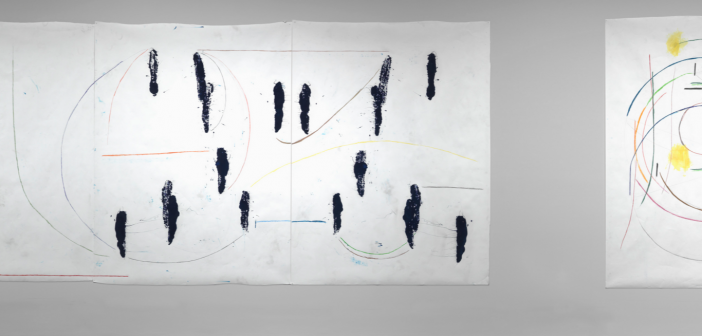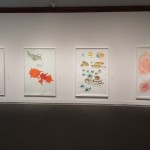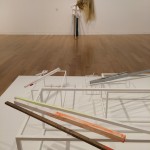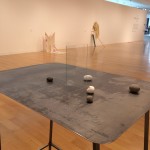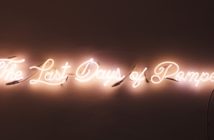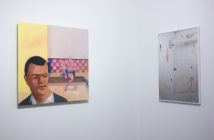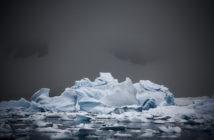Drawing Redefined, on view at deCordova Sculpture Park and Museum through March 20, 2016, is an entrancing show, with a presentation that is at once spare and sumptuous. All the works on view spring from a drawing practice, although they are also rooted in a sculptural tradition. Throughout the show, the audience is prompted to consider process as conceptual content—a prioritization that may lead one to think about the origins of the categories of art-making, and whether this categorization is in fact helpful. The five exhibiting artists: Roni Horn, Esther Kläs, Joelle Tuerlinckx, Richard Tuttle, and Jorinde Voigt, did not create the pieces chosen for the exhibition as preparation for other work, but rather as a means of understanding and progressing in their chosen (and wide-ranging) media. As a satisfying extension of this premise, each artist carries forth their drawing discipline in distinctive ways.

Installation view, Joëlle Tuerlinckx, untitled site-specific installation, 2015, background, Richard Tuttle, 'Looking for the Map 11,' 2013-14.
A host of multi-directional angles open the exhibition with works by Richard Tuttle, Roni Horn, and Joelle Turlinckx. They each occupy different zones of space within the gallery, with Tuttle’s mixed media constructs occupying the lower quadrant of the wall and the adjacent patch of the floor, Horn’s large-scale framed collages dominating the walls, and Turlinckx’s pieces standing on the floor. Tuttle’s Flower meets viewers first and is initially jarring in its simplicity. The light-pink painted-wood relief rests on the floor like tiles positioned in a four-square. In an exhibition whose title asks us to consider the boundaries of drawing, Tuttle uses negative space as a form of mark-making; the absences between each piece of wood create borders that enable the four pieces to become a single object. Another of his works, Looking for the Map 11, (2013-14) leans against the wall, like a lopsided wooden pitchfork dressed in dashing swathes of fabric. From further away, across the gallery, an even more appealing view of Looking for the Map 11 comes from just beyond a floor arrangement, Volume d’Air, by Turlinckx.
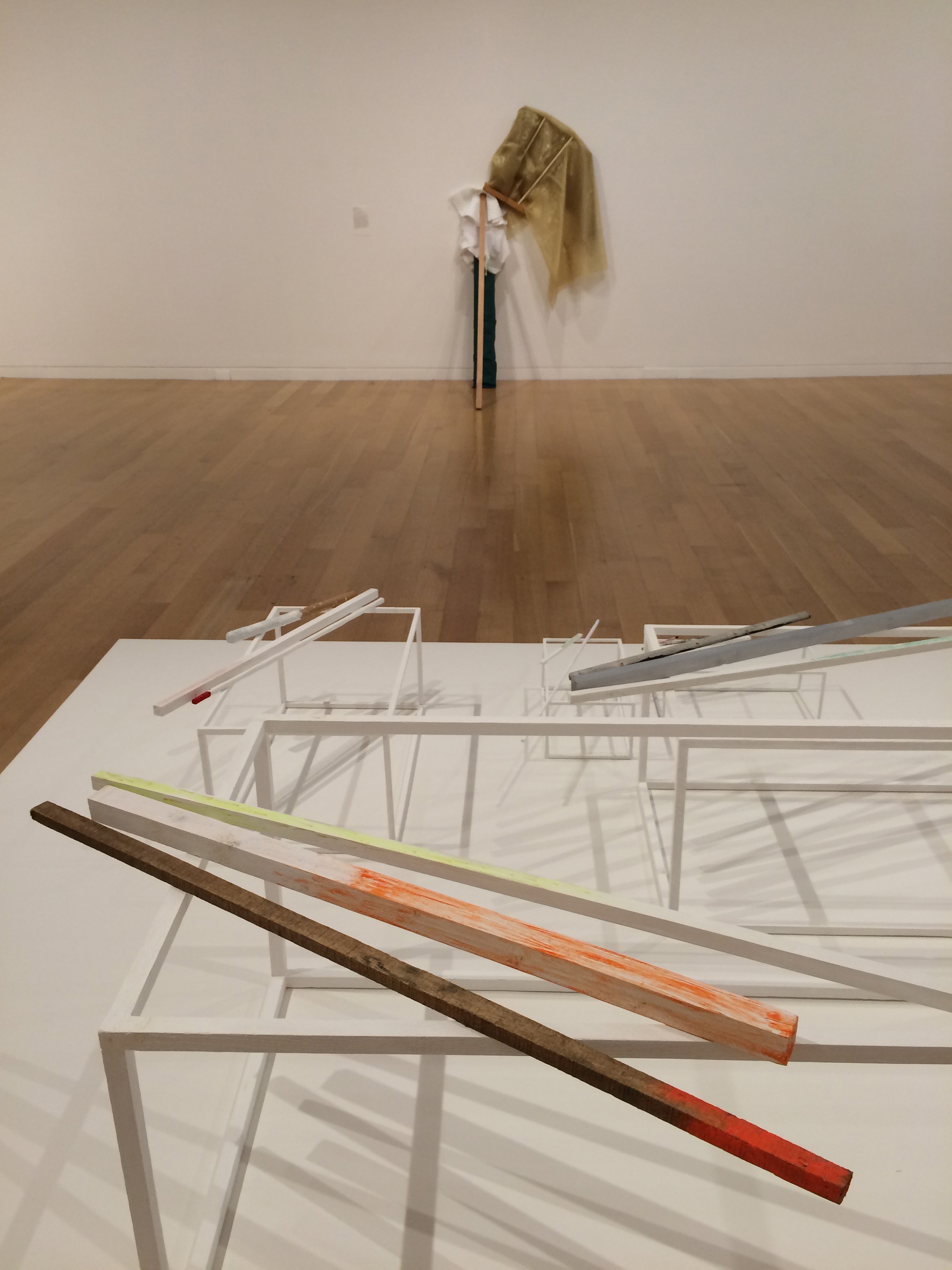
Installation view, Joëlle Tuerlinckx, untitled site-specific installation, 2015, background, Richard Tuttle, 'Looking for the Map 11,' 2013-14.
The connection between Tuttle’s Looking for the Map 11 and Turlinckx’s Volume d’Air is one of many alluring sightlines afforded throughout the gallery. Turlinckx’s works connect with those of Horn and Tuttle through similar gestures and colors, and yet her pieces are inscrutable, incorporating found objects laid out in oblique spatial relationships on white rectangular frames. These works do not lend themselves to resolved moments of gestalt or narrative, instead prompting close and sustained attention. While art historical references to minimalist artists such as Sol Lewitt and Fred Sandback are apparent in the first gallery space of this exhibition, these allusions are softened Tuerlinckx’s work also references Robert Rauschenberg’s impulse to integrate art and life. She collects and assembles found objects, but rather than collaging them into combine paintings, she allows them to maintain their autonomy as objects. In her work Glass scale model '5 stones b/n (1979 - 2014) she places the found objects on the surface of a table; from afar, the tabletop assemblage is understated, and from close up, it is the most captivating piece in the exhibition. The piece is simple in its materials and changeable in its arrangement, yet resolved in its composition. Two panes of glass balance perpendicularly, each standing on one side. Their delicate balance arouses a sense of danger and gives context to the placement of the small stones. The steel table is stained, hinting at the fact that it was once a working surface in her studio, and also that this work was twenty years in making.
In Glass scale model, the rocks have autobiographical significance, as Tuerlinckx collected them over time, but they also contain formal significance, as shapes, colors and textures that contribute to an aesthetic appreciation of the work. As the viewer walks around the table, they become conscious of the delicacy of the glass standing on its edge, the rocks that could easily be moved, and of the manifold compositional possibilities of the work. Ultimately, it is not personal narrative that emerges from this work, but rather a deep sense of the many hours that the artist spent considering the relationship of each component in time and space.
While Glass scale model is a definitive part of the exhibition, Horn’s large-scale drawings anchor the gallery space. Crowds of short blue lines are suspended, behaving as a combination of shrapnel and swarms. The drawings dissect motion and visual decision-making, providing hints about a system that guided her process where Tuerlinckx and Tuttle do not. From close-up, one becomes intimately aware of Horn’s persistent drive to make marks, then cut, arrange, and rearrange them. Her finished works demand a meditative amount of attention from viewers in order to fully analyze them. The three massive drawings, Then 2, Through 1, and Or 3, engulf one’s field of view with dynamic marks of pigment and graphite. While it is possible to trace specific decisions the artist made, one can also step back and experience the work as a force of nature, like the snapshot of a starling murmuration.
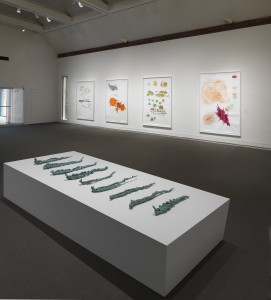
Installation view of work by Jorinde Voigt, 'Drawing Redefined: Roni Horn, Esther Kläs, Joëlle Tuerlinckx, Richard Tuttle, and Jorinde Voigt,' deCordova Sculpture Park and Museum, Lincoln, MA, Photograph by Clements Photography and Design, Boston.
The second gallery does not hold together as powerfully as the first space, as it seemingly relies on older definitions of drawing. On the furthest walls hang monoprints on paper by Esther Kläs. Her drawings, made in part with arcing gestures that connect impressions made with loofah dipped in ink have the appearance of studies: provisional maps made to help realize her sculptural works. They seem unfinished, and would perhaps have been better served by including examples of her completed sculptures. Jorinde Voigt’s works, on the other hand, are highly elaborate and polished. Her series of large-scale ink and color drawings demonstrate a systematic visual vocabulary with surreal imagery. In creating the drawings, Voigt first maps the movements of her entire body, and then translates her full-body experience into a symbolic language of illusionistic organic shapes that float on a flat background. These forms are accented by lines, arrows, and a key at the bottom of each drawing.
The second gallery also includes a few works on paper and short films by Tuerlinckx. On a small screen plays two of her films on a loop. The second one, STUDY FILM(s) from the series water, paper, sun, stones, wind, consists of seven minutes of yellow grid paper soaking in water. Despite the simplicity of the subject, the video is surprisingly engaging. Tuerlicknx’s fingers occasionally shift the paper in the water, sometimes gently, and at other times rigorously. The frame remains consistently close-up throughout the video. The number of sheets of paper gradually increases, and as the layers float together, we hear the sound of the water, with no voices or studio setting beyond. Gradually, there are tiny hints of a setting: a white tablecloth with a red flower print may be glimpsed at the edge of the water bin, birds call, and a plane can be heard. Watching this meditative piece, the viewer becomes more attuned to both their immediate surroundings and to those on the screen.
Some of the artworks in Drawing Redefined are delicate or seemingly unfinished while others are highly realized: a range that prompts viewers to avoid simple conclusions about the state of contemporary drawing. The works by these five artists were arranged to consider an expanded definition of drawing engaging process, materials, and time. This premise arms viewers with a consistent framework to engage with the work, at times leading to more questions—a good thing in the context of contemporary art. Observing the show, one often experiences the sensation of floating beside or above the artwork; a response that demonstrates how the work engages us with the imaginative impulse of each artist. The artists presented do not so much share ideas as enable us to travel with them for a short period of time through the paces of bringing their art into being.
Drawing Redefined is on view at the deCordova Sculpture Park and Museum through March 20, 2016.
- Installation view, Joëlle Tuerlinckx, untitled site-specific installation, 2015, background, Richard Tuttle, ‘Looking for the Map 11,’ 2013-14.
- Installation view of work by Jorinde Voigt, ‘Drawing Redefined: Roni Horn, Esther Kläs, Joëlle Tuerlinckx, Richard Tuttle, and Jorinde Voigt,’ deCordova Sculpture Park and Museum, Lincoln, MA.
- Installation view, Joëlle Tuerlinckx, untitled site-specific installation, 2015, background, Richard Tuttle, ‘Looking for the Map 11,’ 2013-14.
- Installation view, foreground: Joëlle Tuerlinckx, ‘Glass Scale Model, 5 stones b/n,’ 1979 – 2014, steel, glass, glue, stones. Background, L-R: Richard Tuttle, ‘One,’ 1987, and ‘Looking for the Map 11,’ 2013-14, in ‘Drawing Redefined: Roni Horn, Esther Kläs, Joëlle Tuerlinckx, Richard Tuttle, and Jorinde Voigt,’ deCordova Sculpture Park and Museum, Lincoln, MA.
- Installation view of work by Jorinde Voigt, ‘Drawing Redefined: Roni Horn, Esther Kläs, Joëlle Tuerlinckx, Richard Tuttle, and Jorinde Voigt,’ deCordova Sculpture Park and Museum, Lincoln, MA, Photograph by Clements Photography and Design, Boston.
- Esther Kläs, ‘BA/JJ-J,’ 2013 , oil-based ink and colored pencil on paper, 79 ½ × 177 inches (three panels) and Esther Kläs, ‘BA/SUN,’ 2013, colored pencil on paper, 81 ¼ × 59 inches, Courtesy of the artist and Peter Blum Gallery, New York, Photograph by Clements Photography and Design, Boston.
- Installation view, ‘Drawing Redefined: Roni Horn, Esther Kläs, Joëlle Tuerlinckx, Richard Tuttle, and Jorinde Voigt,’ deCordova Sculpture Park and Museum, Lincoln, MA, Photograph by Clements Photography and Design, Boston.

